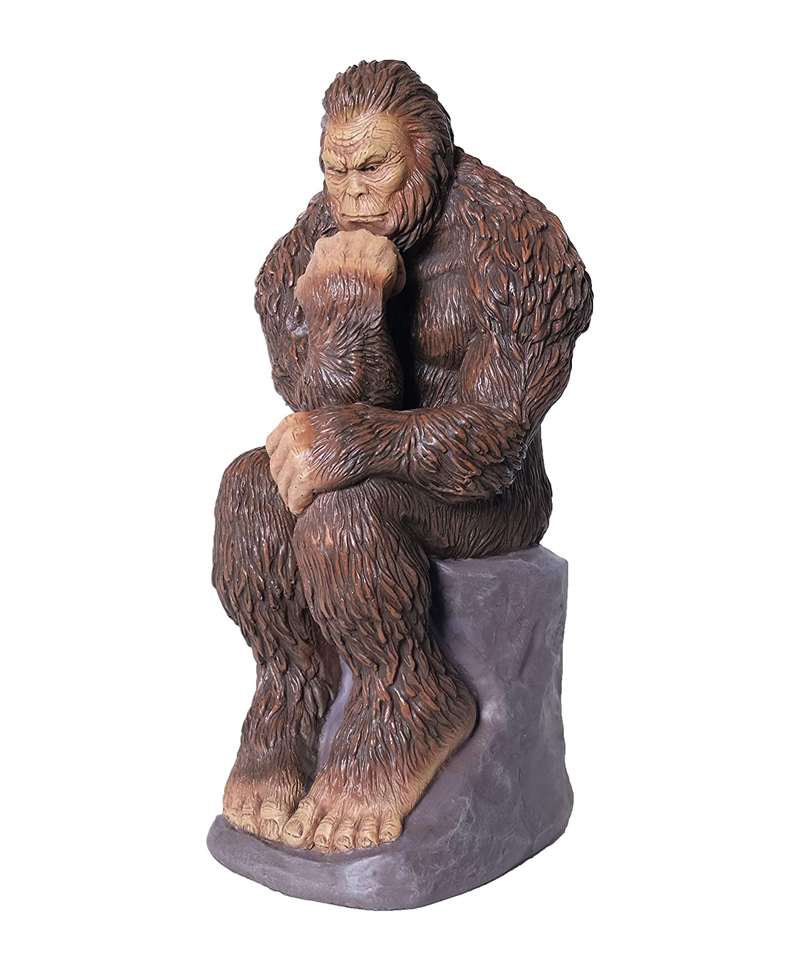Bigfoot the Thinker Statue
Evading detection to become a mythical legend, Bigfoot the Thinker has paused here to plan his next move. Known throughout the world as Bigfoot, Yeti or Sasquatch, this unique Bigfoot Thinker Statue allows you to host your own bigfoot sighting right in your own garden. Sculpted by hand by Bella Haus Design, this Bigfoot statue is made with a durable resin that is weather-resistant for safe use indoors and out, and features life-like details in various shades of brown for a realistic appearance that is sure to delight bigfoot believers and seekers. The Thinker (French: Le Penseur) is a bronze sculpture by Auguste Rodin, usually placed on a stone pedestal. The work depicts a nude male figure of heroic size sitting on a rock. He is seen leaning over, his right elbow placed on his left thigh, holding the weight of his chin on the back of his right hand. The pose is one of deep thought and contemplation, and the statue is often used as an image to represent philosophy. Rodin first conceived the figure as part of his work The Gates of Hell commissioned in 1880, but the first of the familiar monumental bronze castings was made in 1904, and is now exhibited at the Musée Rodin, in Paris.
There are also 27 other known full-sized castings, in which the figure is approximately 185 cm (73 inches) high, although not all were made during Rodin’s lifetime and under his supervision. There are various other versions, several in plaster, and studies and posthumous castings exist in a range of sizes. The Thinker was initially named The Poet (French: Le Poète), and was part of a large commission begun in 1880 for a doorway surround called The Gates of Hell. Rodin based this on The Divine Comedy of Dante Alighieri, and most of the figures in the work represented the main characters in the poem with The Thinker at the center of the composition over the doorway and somewhat larger than most of the other figures. Some critics believe that it was originally intended to depict Dante at the Gates of Hell, pondering his great poem. Other critics reject that theory, pointing out that the figure is naked while Dante is fully clothed throughout his poem, and that the sculpture’s physique does not correspond to Dante’s effete figure. The sculpture is nude, as Rodin wanted a heroic figure in the tradition of Michelangelo, to represent intellect as well as poetry.
This detail from the Gates of Hell was first named The Thinker by foundry workers, who noted its similarity to Michelangelo’s statue of Lorenzo de Medici called Il Pensieroso (The Thinker), and Rodin decided to treat the figure as an independent work at a larger size. The figure was designed to be seen from below and is normally displayed on a fairly high plinth, although the heights vary considerably chosen by the various owners. The Thinker has been cast in multiple versions and is found around the world, but the history of the progression from models to castings is still not entirely clear. About 28 monumental-sized bronze casts are in museums and public places. In addition, there are sculptures of different study-sized scales and plaster versions (often painted bronze) in both monumental and study sizes. Some newer castings have been produced posthumously and are not considered part of the original production. Rodin made the first small plaster version around 1881. The first full-scale model was presented at the Salon des Beaux-Arts in Paris in 1904. A public subscription financed a bronze casting, which became the property of the City of Paris, and was put in front of the Panthéon. In 1922, the original bronze was moved to the Rodin Museum. Bigfoot the Thinker Statue sizes: 14.1 inches / 36 cm x 9.2 inches / 23.5 cm x 7.4 inches / 19 cm.
Bigfoot Thinker Statue on Amazon.
Bigfoot Thinker Statue on eBay.
Bigfoot Statues and Symbolic Statues.




You must be logged in to post a comment.